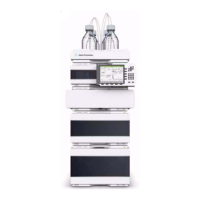Agilent 1200 Infinity Series DAD User Manual 105
Optimizing the Detector
5
Optimizing the Detector Regarding to the System
Peak Width, Response Time and Data Collection Rate
The peak width setting, response time and data rate in the detector are all
linked. The available settings are shown in Table 9 on page 106. It is important
to set this correctly for optimum sensitivity and to preserve the resolution
achieved in the separation.
The detector internally acquires data points faster than is needed for a
chromatogram and processes them to produce the signal seen by the data
system. Part of the processing reduces the data to an appropriate data rate
which allows the chromatographic peaks to be accurately drawn. As with most
analytical determinations groups of readings are effectively averaged to
reduce error in the result. The detector bunches raw data points and produces
the output signal data at the required data collection rate by an electronic
filtering process. If the resulting data rate is too slow (over filtering) the peak
heights will be reduced and the resolution between them reduced; too fast and
the data is noisier than it need be to accurately profile narrow peaks.
The peak width setting in the detector allows the user to correctly set these
parameters without needing any knowledge other than sight of the
chromatogram integration results to see how wide the peaks are. The peak
width setting should be set for the narrowest peak width observed in the
chromatogram. If it is set too wide it will make the peaks appear lower in
height and wider (and potentially less resolved) and if it is set too narrow it
will increase the baseline noise unnecessarily. Essentially the software uses
this value to set the data collection rate such that it collects enough data
points over the narrowest peaks and it is aiming for 15 to 25 points across a
peak. The 1290 Infinity DAD can collect at a maximum 160 Hz if required
which would allow enough data points to be collected over a peak that is only
0.1 s wide. The response time setting is another way of indicating how this
filtering is set. It is measured in seconds and is about one-third of the peak
width value (which is measured in minutes). It effectively shows how quickly
the plotted signal responds to a step change in the input signal.
The full spectra is not available under all conditions.
Based on the data points, the scan data rate is reduced, see Ta b l e 9 on page 106.

